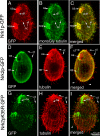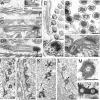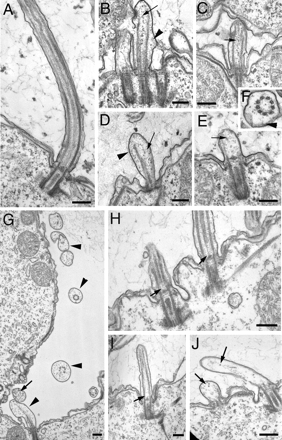Members of the NIMA-related kinase family promote disassembly of cilia by multiple mechanisms
- PMID: 16611747
- PMCID: PMC1474788
- DOI: 10.1091/mbc.e05-05-0450
Members of the NIMA-related kinase family promote disassembly of cilia by multiple mechanisms
Abstract
The genome of Tetrahymena thermophila contains 39 loci encoding NIMA-related kinases (NRKs), an extraordinarily large number for a unicellular organism. Evolutionary analyses grouped these sequences into several subfamilies, some of which have orthologues in animals, whereas others are protist specific. When overproduced, NRKs of three subfamilies caused rapid shortening of cilia. Ultrastructural studies revealed that each NRK triggered ciliary resorption by a distinct mechanism that involved preferential depolymerization of a subset of axonemal microtubules, at either the distal or proximal end. Overexpression of a kinase-inactive variant caused lengthening of cilia, indicating that constitutive NRK-mediated resorption regulates the length of cilia. Each NRK preferentially resorbed a distinct subset of cilia, depending on the location along the anteroposterior axis. We also show that normal Tetrahymena cells maintain unequal length cilia. We propose that ciliates used a large number of NRK paralogues to differentially regulate the length of specific subsets of cilia in the same cell.
Figures








Similar articles
-
A NIMA-related kinase, Cnk2p, regulates both flagellar length and cell size in Chlamydomonas.J Cell Sci. 2005 Aug 1;118(Pt 15):3317-26. doi: 10.1242/jcs.02455. Epub 2005 Jul 19. J Cell Sci. 2005. PMID: 16030138
-
The mammalian Nek1 kinase is involved in primary cilium formation.FEBS Lett. 2008 Apr 30;582(10):1465-70. doi: 10.1016/j.febslet.2008.03.036. Epub 2008 Apr 1. FEBS Lett. 2008. PMID: 18387364
-
Phylogenetic analysis of the Neks reveals early diversification of ciliary-cell cycle kinases.PLoS One. 2007 Oct 24;2(10):e1076. doi: 10.1371/journal.pone.0001076. PLoS One. 2007. PMID: 17957258 Free PMC article.
-
Mechanism of ciliary disassembly.Cell Mol Life Sci. 2016 May;73(9):1787-802. doi: 10.1007/s00018-016-2148-7. Epub 2016 Feb 11. Cell Mol Life Sci. 2016. PMID: 26869233 Free PMC article. Review.
-
Nima- and Aurora-related kinases of malaria parasites.Biochim Biophys Acta. 2013 Jul;1834(7):1336-45. doi: 10.1016/j.bbapap.2013.02.022. Epub 2013 Feb 24. Biochim Biophys Acta. 2013. PMID: 23462523 Review.
Cited by
-
Native doublet microtubules from Tetrahymena thermophila reveal the importance of outer junction proteins.Nat Commun. 2023 Apr 15;14(1):2168. doi: 10.1038/s41467-023-37868-0. Nat Commun. 2023. PMID: 37061538 Free PMC article.
-
A NIMA-related kinase, CNK4, regulates ciliary stability and length.Mol Biol Cell. 2016 Mar 1;27(5):838-47. doi: 10.1091/mbc.E15-10-0707. Epub 2016 Jan 13. Mol Biol Cell. 2016. PMID: 26764095 Free PMC article.
-
Dynein-2 affects the regulation of ciliary length but is not required for ciliogenesis in Tetrahymena thermophila.Mol Biol Cell. 2009 Jan;20(2):708-20. doi: 10.1091/mbc.e08-07-0746. Epub 2008 Nov 19. Mol Biol Cell. 2009. PMID: 19019986 Free PMC article.
-
Macronuclear genome sequence of the ciliate Tetrahymena thermophila, a model eukaryote.PLoS Biol. 2006 Sep;4(9):e286. doi: 10.1371/journal.pbio.0040286. PLoS Biol. 2006. PMID: 16933976 Free PMC article.
-
Hyperglutamylation of tubulin can either stabilize or destabilize microtubules in the same cell.Eukaryot Cell. 2010 Jan;9(1):184-93. doi: 10.1128/EC.00176-09. Epub 2009 Aug 21. Eukaryot Cell. 2010. PMID: 19700636 Free PMC article.
References
-
- Berman S. A., Wilson N. F., Haas N. A., Lefebvre P. A. A novel MAP kinase regulates flagellar length in Chlamydomonas. Curr. Biol. 2003;13:1145–1149. - PubMed
-
- Bradley B. A., Quarmby L. M. A NIMA-related kinase, Cnk2p, regulates both flagellar length and cell size in Chlamydomonas. J. Cell Sci. 2005;118:3317–3326. - PubMed
-
- Bradley B. A., Wagner J. J., Quarmby L. M. Identification and sequence analysis of six new members of the NIMA-related kinase family in Chlamydomonas. J. Eukaryot. Microbiol. 2004;51:66–72. - PubMed
Publication types
MeSH terms
Substances
LinkOut - more resources
Full Text Sources

